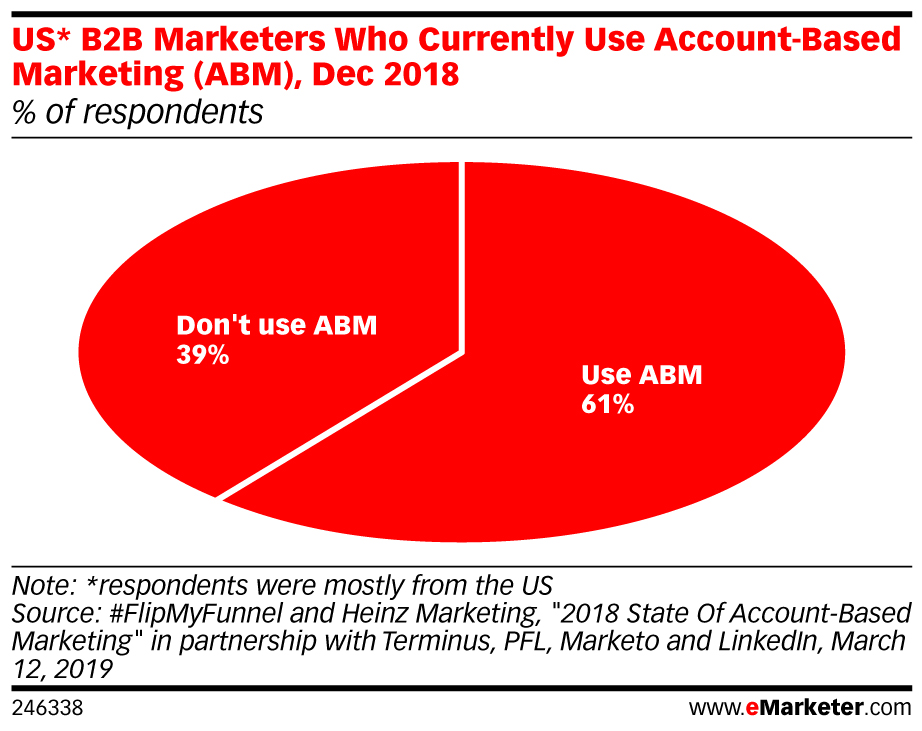In January 2019, IAB published a predictions piece, where Account-Based Marketing (ABM) and the rise of data-driven targeting were identified by IAB B2B Committee members as top trends to watch for this year. The rise of ABM was not surprising given that 61% of B2B marketers claimed to use ABM as of December 2018.

The paper also identified how B2B lags significantly vs. B2C in terms of digital spend, especially on mobile where the majority of total digital revenue is reported and where consumers spend the vast majority of their time. There are now updated stats that continue to reinforce these points:
- In 2019, it is estimated that the B2B industry will spend 37.3% of digital ad dollars on mobile compared to the overall marketplace spend which is estimated to be 70%.
- To highlight the importance of mobile, mobile comprised 65% of all digital ad revenue in 2018, up +8% vs. 2017. (Source: IAB/PwC Revenue Report FY 2018)
- Mobile as a percentage of digital time spent was 71% in 2018, up from 68% in 2017. (Source: Comscore)
While there is growing evidence the B2B mobile gap vs. B2C is lessening over time, IAB felt that more education would help the B2B marketplace embrace the importance of having a digital/mobile strategy to gain quality leads and loyal customers while using an ABM approach. A working group* was formed to create Account-Based Marketing (ABM): How to Identify Audiences Effectively & Execute ABM Strategies in the Digital Marketplace, an IAB Playbook. This playbook is designed to help B2B marketers understand the necessity of having a digital approach in order to jump-start and optimize ABM with the goal of continued adoption.
What is Account-Based Marketing (ABM)?

When applied properly, ABM has many benefits including higher ROI, increased share of wallet, higher win rates, revenue growth, increased client retention, enhanced customer lifetime value and stronger alignment between marketing and sales.
What does the IAB ABM Playbook Cover?
Detailed in the playbook are key considerations that can be universally adopted to implement ABM as an effective part of the B2B marketing mix including:
- Keys to Success
- Benefits
- How to Identify Audiences Effectively
- Key Elements to Executing an ABM Strategy
- Privacy Considerations
The co-chairs of the working group highlighted two key ABM insights covered in the playbook:
For successful ABM targeting, you must not only identify the “right” accounts but also identify the key influencers in the buying committee for each account.
One of the main challenges with ABM is identifying audiences to target. The playbook highlights five components to do so effectively. B2B marketers using an ABM strategy must understand their Ideal Customer Profile (ICP), use available first and third-party data, understand the buying committee, ensure marketing & sales alignment and utilize account scoring to prioritize. Decision-makers are influenced by several members from varying departments and seniorities in the B2B buying process (an average of 6.8 individuals make up the buying committee), and it’s important to identify who the “influencers” are at each specific account.
– Darragh Fitzpatrick, SVP of Sales & Account Management at Rollworks, IAB ABM Co-chair
Programmatic as an effective strategy for activating personalized ABM programs and a way to win on mobile.
Account-Based Marketing requires access to data. As programmatic is a standard digital approach used by B2B marketers to cast a wide net, it collects data that can enhance ABM both targeting as well as attribution efforts. This data can be used to help personalize the experience for the target accounts and determine where each individual is in the buyer’s journey to move them further down the funnel. This playbook outlines many digital activations to be considered as a part of an ABM execution strategy including programmatic tactics such as retargeting, OTT/Connected TV (CTV) and programmatic native.
– Ethan Simblist, VP Digital Solutions at MeritDirect LLC, IAB ABM Co-chair
Specifically related to mobile, the playbook points out that mobile can be used for optimization and scale throughout the ABM journey. While there may be challenges with mobile such as understanding mobile web/in-app differences and lack of cookies, mobile is a growth opportunity for the B2B industry, specifically for those using ABM, that should be taken advantage of to reach prospects where they spend the most time.
IAB’s intent with this playbook is to provide B2B marketers with the knowledge and resources to effectively start and execute ABM campaigns so companies of any size can implement ABM to grow their businesses with mobile in mind.
View The Account-Based Marketing Playbook Here
IAB will be continuing the conversation and releasing a playbook focused specifically on ABM measurement in 2020.
* IAB greatly acknowledges and thanks the IAB Account-Based Marketing Working Group member companies for their contributions: AdPushup, Captivate, Digitas LBI, Dun & Bradstreet, Extreme Reach, Eyeota, Havas Media, Instinctive, IPONWEB, KERV Interactive, LinkedIn, MediaMath, MeritDirect LLC, Merkle, Netsertive, Pixalate, RollWorks and Ziff Davis B2B.



